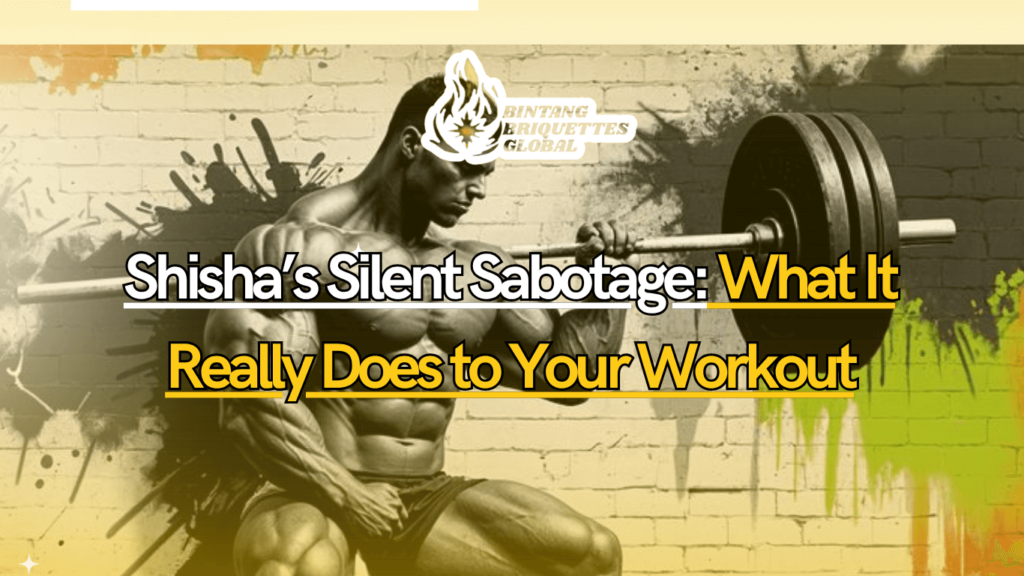Introduction
bintangbriquettes.com – Shisha’s Silent Sabotage, also known as hookah or waterpipe smoking, has become a trendy and social pastime, especially among young adults globally. The sweet-scented tobacco, social gatherings, and perceived exotic allure contribute to its popularity. However, beneath the fragrant smoke lies a quiet adversary to your physical well-being—particularly for fitness enthusiasts. This article explores the intricate connection between shisha and athletic performance, revealing the often-overlooked ways in which this habit can silently undermine your physical progress and overall health.
1. The Physiology of Fitness and Oxygen
To understand the damage shisha can inflict on fitness, it is crucial to first grasp the body’s physiological needs during physical exertion. Oxygen plays a central role in exercise. Muscles rely on a continuous, abundant supply of oxygen to sustain movement, endure stress, and recover post-exercise. The cardiovascular and respiratory systems work in concert to deliver oxygen efficiently while expelling carbon dioxide. Any disruption in this supply chain—whether from smoking or other factors—can severely impair stamina, recovery, and performance.
2. What Happens When You Smoke Shisha?
Inhaling shisha smoke does more harm than many realize. Each puff brings in a toxic cocktail that includes:
- Carbon monoxide (CO): Binds to hemoglobin in the blood, reducing its oxygen-carrying capacity.
- Nicotine: A stimulant that elevates heart rate and blood pressure.
- Heavy metals and carcinogens: These accumulate in organs and damage cellular function.
- Particulate matter: Fine particles that infiltrate the lungs and reduce respiratory efficiency.
Alarmingly, a typical one-hour shisha session can equal inhaling the smoke of over 100 cigarettes, drastically increasing exposure to these harmful substances.
3. Impact on Cardiovascular Endurance
Athletes, especially those involved in endurance sports like running or swimming, rely heavily on the cardiovascular system to perform. Shisha interferes by:
- Lowering oxygen delivery through CO-induced hypoxia.
- Causing vasoconstriction, which restricts blood flow.
- Elevating oxidative stress levels, leading to quicker fatigue and muscle damage.
Even casual smoking sessions can significantly reduce VO2 max—the measure of the body’s maximum oxygen utilization—which translates into earlier exhaustion during workouts.
4. Muscular Performance and Recovery
Muscles demand a rich supply of nutrients and oxygen to perform optimally and recover swiftly. Shisha use interrupts this by:
- Decreasing blood circulation due to narrowed arteries.
- Triggering systemic inflammation that delays tissue healing.
- Increasing muscle soreness and hindering strength development.
Nicotine’s appetite-suppressing effect can also lead to nutrient deficiencies, compounding poor muscle development and sluggish recovery.
5. Lung Capacity and Breathing Efficiency
Lung function is essential for peak physical output. Shisha smoke deteriorates this capability by:
- Thickening bronchial walls, reducing airflow.
- Decreasing lung elasticity, making breathing laborious.
- Stimulating excessive mucus production and irritation.
This often results in wheezing, breathlessness, and reduced endurance, especially during high-intensity training or competitive sports.
6. Hormonal Disruption and Metabolism
Toxins in shisha smoke negatively affect hormonal balance, including:
- Lowering testosterone levels, critical for muscle synthesis and energy.
- Increasing cortisol, a stress hormone that breaks down muscle tissue.
- Slowing metabolism, making fat loss more difficult and increasing fatigue.
These imbalances make it harder for athletes to build lean muscle, recover quickly, or maintain optimal body composition.
7. Immune Function and Injury Risk
A strong immune system protects athletes from illness and injury. Shisha compromises this by:
- Delaying recovery from wounds or muscle tears.
- Increasing chronic inflammation, which stresses the body.
- Heightening susceptibility to respiratory infections.
The cumulative effect Shisha’s Silent Sabotage is increased downtime, inconsistent training, and heightened injury risk.
8. Mental Focus and Performance
Athletic success requires mental sharpness. Shisha impairs this critical edge by:
- Diminishing concentration and reaction time due to carbon monoxide exposure.
- Creating mood swings associated with nicotine highs and withdrawals.
- Disrupting sleep patterns, a key component of physical recovery.
Shisha’s Silent Sabotage Cognitive dullness and lack of focus can diminish performance in skill-based sports and high-pressure situations.
9. Long-Term Athletic Consequences
While short-term effects may be subtle, long-term damage from regular shisha use includes:
- Chronic obstructive pulmonary disease (COPD)
- Accelerated cardiovascular aging
- Decreased athletic lifespan and performance ceiling
Such outcomes can limit career longevity, hinder progression, or even force premature retirement from competitive sports.
10. Myths vs. Reality
- Myth: Shisha is safe because smoke passes through water.
Reality: Water barely filters toxins and doesn’t remove carbon monoxide or heavy metals. - Myth: Occasional shisha use doesn’t harm fitness.
Reality: Even one session can reduce oxygen transport and impair recovery. - Myth: Herbal shisha is non-toxic.
Reality: Herbal blends still produce harmful tar and CO when burned.
11. Athletes Who Quit: Real-Life Turnarounds
Athletes who ditch shisha often report:
- Noticeably better lung capacity and stamina within weeks.
- Reduced soreness and quicker post-training recovery.
- Improved sleep, mood, and overall energy levels.
These changes not only enhance performance but also extend an athlete’s training and competitive longevity.
12. Alternatives for Relaxation
For those who enjoy shisha as a way to relax, healthier options include:
- Herbal teas like chamomile or ashwagandha for stress relief.
- Guided breathing exercises or mindfulness meditation.
- Steam rooms, saunas, or nature walks for detox and calm.
- Social meetups centered around wellness activities or mocktails.
These activities provide the relaxation and social interaction many seek from shisha—without the harmful side effects.
13. Tips to Quit Shisha for Athletes
If you’re ready to prioritize your performance, these steps can help:
- Set clear athletic objectives linked to quitting.
- Replace smoking with post-workout routines like massage or ice baths.
- Build a supportive circle of health-minded peers and coaches.
- Try nicotine replacement options if needed.
- Journal or track progress to stay motivated.
Conclusion: Shisha’s Silent Sabotage
Shisha may offer a sense of relaxation or cultural connection, but for athletes and fitness enthusiasts, its costs far outweigh the benefits. From impairing oxygen delivery to hindering muscle recovery, shisha is an unseen adversary to your athletic goals. The good news? The body is incredibly resilient. Quitting shisha can lead to rapid improvements in energy, stamina, and overall wellness.
Your body is your most valuable asset in training and competition. Protect it. Fuel it with clean air, not smoke. Let it thrive—without sabotage.

